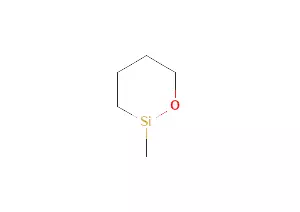Polymethylhydrogensiloxane Information
Chemical Name | Poly(methylhydrosiloxane) |
Other Name | Polymethylhydrogensiloxane; Methyl high hydrogen silicone oil; Polydimethylhydrosiloxan |
CAS | 63148-57-2 |
EINECS | 613-152-3 |
Type | Food additives; Catalysts and additives; Organic raw materials |
Molecular Formula | C7H22O2Si3 |
Molecular Weight | 222.5 |

Polymethylhydrosiloxane, as a silicone oil with wide applications in the fields of biology and chemistry, its unique chemical structure and properties make it play an indispensable role in many fields.
Under specific chemical reaction conditions, especially with the ingenious action of metal salt catalysts, this silicone oil can undergo cross-linking reactions at relatively low temperatures, thereby forming a uniform and dense film. This film has excellent waterproof performance and can stably adhere to the surfaces of various materials. Whether it is soft fabrics, smooth glass, hard ceramics, or common materials in daily life such as paper and leather, or durable metals, cement, and elegant marble, it can provide reliable waterproof protection for them. Especially in the application of fabrics, its waterproof effect is particularly remarkable. It can effectively prevent the penetration of water while not affecting the breathability of the fabric itself, allowing the wearer to feel comfortable and dry.
It is worth mentioning that when methyl hydrosilicone oil emulsion and methyl hydroxyl silicone oil emulsion are ingeniously used in combination, the synergistic effect they produce is truly astonishing. This combination not only further enhances the water resistance of the fabric, ensuring it remains dry in a humid environment, but also significantly improves the various physical properties of the fabric. For instance, it can effectively enhance the tear strength of fabrics, making them more resilient and durable. Enhance the friction strength and reduce wear during daily use; Enhance the anti-stain performance to make the fabric easier to clean and maintain. Meanwhile, this combination can also improve the hand feel of the fabric, making it softer and smoother to the touch and enhancing the wearing experience. In addition, it also has a positive impact on the sewing performance of fabrics, making the sewing process smoother and the finished products more exquisite and beautiful.
In addition to its outstanding performance in the field of fabrics, polymethylhydrosiloxane also plays a significant role in paper processing. It can be used as an anti-sticking mold release agent for paper, effectively preventing the adhesion of paper during the production process, and improving production efficiency and paper quality. Meanwhile, it can also be used as a crosslinking agent to further enhance various properties of paper, such as strength and toughness, providing strong support for the wide application of paper.
Polymethylhydrogensiloxane Properties
Melting point | <-60°C |
Boiling point | 142 °C(lit.) |
density | 1.006 g/mL at 25 °C (lit.) |
vapor pressure | 38 hPa (20 °C) |
refractive index | n20/D 1.382(lit.) |
Fp | 204 °C |
storage temp. | Store below +30°C. |
solubility | Soluble in most ethereal, chlorinated, or hydrocarbon solvents as well as EtOH, i-PrOH, warm DMF, and warm NMP; insoluble in MeOH, DMSO, acetonitrile, and water |
form | liquid |
Specific Gravity | 0.98 |
PH | 7 (H2O) |
Water Solubility | Not miscible or difficult to mix in water. |

Polymethylhydrogensiloxane Uses
In today's numerous industrial fields and the production of daily necessities, polymethylhydrosiloxane plays a crucial role. It is widely used as a water repellent, defoamer and crosslinking agent, and its application scope covers multiple aspects such as textiles, rubber, leather, paper and various building materials. Especially in the manufacturing process of items involving chain crosslinking, it plays an indispensable role.
Polymethylhydrosiloxane, as a key chemical raw material, has demonstrated unique value in the preparation of block copolymers. Through specific chemical reactions and technological processes, it can provide basic substances for the synthesis of block copolymers, thereby further expanding its application potential in the field of materials science.
It is worth mentioning that under the special effect of steel salt stimulants, polymethylhydrosiloxane can undergo cross-linking reactions in a relatively low-temperature environment, thereby forming a dense and uniform film-like substance. This film can be attached to the exterior of different products, providing them with reliable waterproof protection. Whether it is glassware, porcelain, paper, natural leather, steel materials, cement structures or marble surfaces, etc., the waterproof film formed by polymethylhydrosiloxane can effectively prevent water from penetrating, ensuring that the performance and quality of the products are not affected. Especially in the waterproof treatment of textiles, its application is particularly prominent, which can significantly improve the waterproof performance of textiles and enable them to maintain good usage performance in a humid environment.
In addition, the combined use of methyl hydrogen silicone oil solution and methyl hydroxyl silicone oil solution has brought about significant effects on the waterproofing and performance optimization of materials. When these two solutions work in synergy, they can not only further enhance the water resistance of the material, effectively preventing water from penetrating into the interior of the material, but also tightly seal the possible air leakage channels within the material structure. For fabrics, this way of combined use has multiple positive impacts. It can significantly enhance the tear strength of the fabric, making it more durable in daily use. Enhance the frictional toughness of the fabric and reduce damage caused by friction; At the same time, it can also enhance the anti-fouling and living performance of the fabric, making the fabric easier to clean and keep tidy. Moreover, after undergoing this special treatment, the hand feel of the textiles will be greatly improved, becoming softer and more comfortable. Whether used in residential environments or commercial places, they can bring people a better experience. In addition, polymethylhydrosiloxane also plays a significant role in the paper production process. It can serve as an anti-sticking release agent and crosslinking agent for paper, ensuring smooth demolding during the production process and enhancing the quality and performance of the paper.




